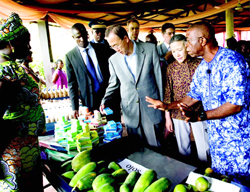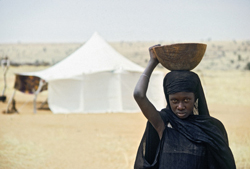UNITED NATIONS IN FOCUS No. 9 May 2011
|
The Least Developed Countries
Africa [33]
Asia [14]
Latin America and the Caribbean [1]
|

Secretary-General Ban Ki-moon at the Centre Songhai, a non-governmental organization specialising in research, training and development of sustainable agricultural practices, in Porto Novo, Benin

Aiming to reduce their own number in half by 2020, the 48 least developed countries (LDCs) are looking for a major advance at negotiations ahead of the Fourth UN Conference on the LDCs (9-13 May, Istanbul, Turkey).
The world's most vulnerable economies and other governments are pressing for measures that would bump 24 countries off the UN's "least developed" category - which denotes low per capita income, low standards of living and human resources, and lack of economic capacity and resilience.
LDCs depend largely on agriculture, which occupies most of their people in backbreaking, low-productivity work; or on mining and petroleum, which are non-labour intensive and produce little spin-off into other areas of domestic economies.
Volatile weather patterns induced by climate change pose an extreme threat to farmers. Many LDCs have low-lying coastlines or are small islands vulnerable to storms and to the effects of rising sea levels. A few are at the other extreme - situated in mountainous areas and relying on the runoff from glacial fields that appear to be receding.
Although only three of the 51 countries in total named to the LDC category by the UN's Development Policy Committee have ever graduated (Botswana, 1994; Cape Verde 2007; and Maldives 2011), there are key areas on which the LDCs are focusing their action. This issue of United Nations in Focus examines five core areas where progress is essential:
Countries as diverse in time and place as the United Kingdom and the United States during the Industrial Revolution, and contemporary China, built dynamic urban expansion on the shoulders of a growing rural sector.
Agriculture is a virtual drag on the economy in the LDCs, with 70 per cent of the population engaged in farming producing only 30 per cent of national income, according to the Food and Agriculture Organization (FAO).
Food prices are on a rising trend since 2007. They are likely to continue upward for the foreseeable future. High prices tend to punish LDC consumers with hunger rather than reward farmers with profits.
However, if higher prices are transmitted from world markets to the markets of local farmers, and infrastructure, farm inputs, and social services are available, there is an opportunity for smallholder LDC farmers, as well as agricultural firms, to benefit.
A study published in April 2011 by the McKinsey consulting firm contends that this moment may be arriving in Africa, where more than three-quarters of the LDCs are located. The report states:
A long-awaited 'green revolution' may be within reach. Many of the continent's governments are adopting market-friendly policies and committing more resources to the sector. Traditional big-donor countries are increasing their expenditures on agriculture, while China and Brazil are also beginning to contribute to the effort. African agriculture's private-sector investment is rising rapidly. High, volatile food prices underline the importance of such development efforts and create not only pressure but also political space for policy makers to act.
Six LDCs - Angola, Ethiopia, Madagascar, Mozambique, Sudan and Tanzania - are on the list of the 11 countries McKinsey says are most likely to benefit, especially if sustainable agricultural practices to ward off the effects of climate change are introduced.
Support for agricultural development and small-scale farmers is an area where the UN's food based agencies - FAO, World Food Programme and International Fund for Agricultural Development - are working in conjunction with a score of other members of a multi-sectoral task force appointed by the Secretary-General to respond to the wake-up call of the 2008 food crisis.
The large majority of farmers in the LDCs are women - most of whom are involved in low-productivity agriculture. A transformation of smallholder farming and diversification of rural as well as urban economies would allow the creative, economic and governance abilities of women to more fully emerge. Essential for this is bringing down structural barriers - discriminatory laws, policies, practices and norms - to gender equality.
The record of LDCs on women's rights and empowerment is spotty, but progress is visible. Some governments, such as Nepal, have taken measures to reduce the earnings gap between men and women. Female literacy rates in LDCs overall have increased from 44 per cent at the end of the 1990s to more than 50 per cent in the second half of the 2000s. Many LDCs are providing direct support to women entrepreneurs.
The success of the Secretary-General's initiative on health care for mothers, infants and children in poor countries is crucial to freeing up women's capacities.
With low domestic savings rates (averaging 10 per cent of gross domestic product), the least developed countries remain dependent on sources of external financing such as official development assistance (ODA). While ODA from traditional donors in the Development Assistance Committee of the OECD has nearly tripled since the previous LDC Conference - from $14 billion in 2001 to nearly $40 billion in 2009 - it remains below target.
LDCs are looking for extra help on climate change adaptation and are coming to rely more on growing aid, trade and investment from rising economies in the South, all while hoping that donors in the North will fulfill aid targets.
They are also looking for a shift in sectoral allocation. The portion of ODA going to economic infrastructure and the productive sector has been in long-term decline since the 1980s. Many LDC governments are looking for a larger share to go to major infrastructure (transport, energy, water, and information and communications technology) and farming, as these productive capacities help to reduce aid dependence and to counteract the effects of the financial and food crises.
It is notable that the two largest countries to graduate from LDC status (Botswana and Cape Verde) also rank the highest among all nations in that category in the Economist Intelligence Unit's democracy rankings.
LDC governments are increasingly aware that legal, democratic and macroeconomic frameworks are among the crucial factors that potential investors assess before making a decision. Since the Brussels Conference on the LDCs in 2001, there has been a general movement toward improvement on governance and social inclusion. There are fewer civil conflicts. Elections are held in almost all 48 LDCs. Progress has been made on judicial and legal systems, corruption and on improving tax collection mechanisms.
LDCs are rich in the hard (mineral) and soft (agricultural) commodities that are at a premium in today's global economy. Possession of these resources has not enabled most of them to escape poverty traps in the past. Countries need to find ways that will bring the proceeds into play in terms of economic diversification.
If returns are more widely spread among populations, growing domestic markets will attract international investment into non-commodity sectors. There are indications this is already starting to occur. Removal of obstacles to overseas markets will also improve motivation for capital to seek out LDCs as bases for manufacture for export. Foreign direct investment (FDI) driven by the commodities boom of the 21st century has been the most rapidly growing source of finance inflows for LDCs. At less than one per cent of the world total of inward FDI, there is ample room for growth in the decade ahead.
Produced by the UN Department of Public Information Strategic Communications Division, May 2011